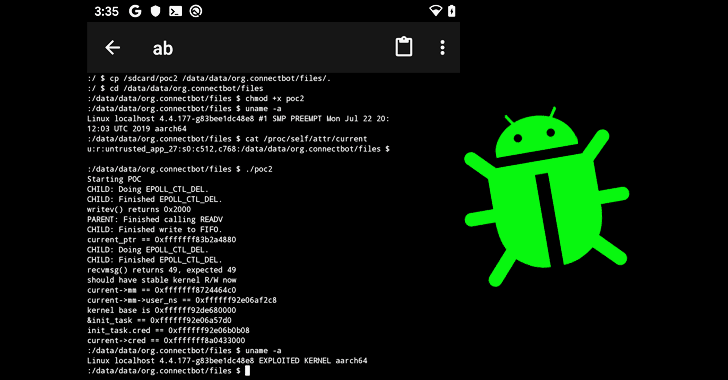Another day, another revelation of a critical unpatched zero-day vulnerability, this time in the world’s most widely used mobile operating system, Android.
What’s more? The Android zero-day vulnerability has also been found to be exploited in the wild by the Israeli surveillance vendor NSO Group—infamous for selling zero-day exploits to governments—or one of its customers, to gain control of their targets’ Android devices.
Discovered by Project Zero researcher Maddie Stone, the details and a proof-of-concept exploit for the high-severity security vulnerability, tracked as CVE-2019-2215, has been made public today—just seven days after reporting it to the Android security team.
The zero-day is a use-after-free vulnerability in the Android kernel’s binder driver that can allow a local privileged attacker or an app to escalate their privileges to gain root access to a vulnerable device and potentially take full remote control of the device.
Vulnerable Android Devices
The vulnerability resides in versions of Android kernel released before April last year, a patch for which was included in the 4.14 LTS Linux kernel released in December 2017 but was only incorporated in AOSP Android kernel versions 3.18, 4.4 and 4.9.
Therefore, most Android devices manufactured and sold by a majority of vendors with the unpatched kernel are still vulnerable to this vulnerability even after having the latest Android updates, including below-listed popular smartphone models :
- Pixel 1
- Pixel 1 XL
- Pixel 2
- Pixel 2 XL
- Huawei P20
- Xiaomi Redmi 5A
- Xiaomi Redmi Note 5
- Xiaomi A1
- Oppo A3
- Moto Z3
- Oreo LG phones
- Samsung S7
- Samsung S8
- Samsung S9
To be noted, Pixel 3, 3 XL, and 3a devices running the latest Android kernels are not vulnerable to the issue.
Android Flaw Can Be Exploited Remotely
According to the researcher, since the issue is “accessible from inside the Chrome sandbox,” the Android kernel zero-day vulnerability can also be exploited remotely by combining it with a separate Chrome rendering flaw.
“The bug is a local privilege escalation vulnerability that allows for a full compromise of a vulnerable device. If the exploit is delivered via the Web, it only needs to be paired with a renderer exploit, as this vulnerability is accessible through the sandbox,” Stone says in the Chromium blog.
“I’ve attached a local exploit proof-of-concept to demonstrate how this bug can be used to gain arbitrary kernel read/write when running locally. It only requires the untrusted app code execution to exploit CVE-2019-2215. I’ve also attached a screenshot (success.png) of the POC running on a Pixel 2, running Android 10 with security patch level September 2019.”
Patches to be Made Available Soon
Though Google will release a patch for this vulnerability in its October’s Android Security Bulletin in the coming days and also notified OEMs, most affected devices would not likely receive the patch immediately, unlike Google Pixel 1 and 2.
“This issue is rated as High severity on Android and by itself requires installation of a malicious application for potential exploitation. Any other vectors, such as via web browser, require chaining with an additional exploit,” the Android security team said in a statement.
“We have notified Android partners, and the patch is available on the Android Common Kernel. Pixel 3 and 3a devices are not vulnerable while Pixel 1 and 2 devices will be receiving updates for this issue as part of the October update.”
Google’s Project Zero division usually gives software developers a 90-day deadline to fix the issue in their affected products before going public with the details and PoC exploits, but in case of active exploits, the team goes public after seven days of privately being reported.
What’s your take? Although this vulnerability is severe and can be used to gain root access to an Android device, users need not worry that much as the exploitation of such issues is mostly limited to targeted attack scenarios.
Nevertheless, it’s always a good idea to avoid downloading and installing apps from third-party app stores and any unnecessary apps, even from the Google Play Store.



